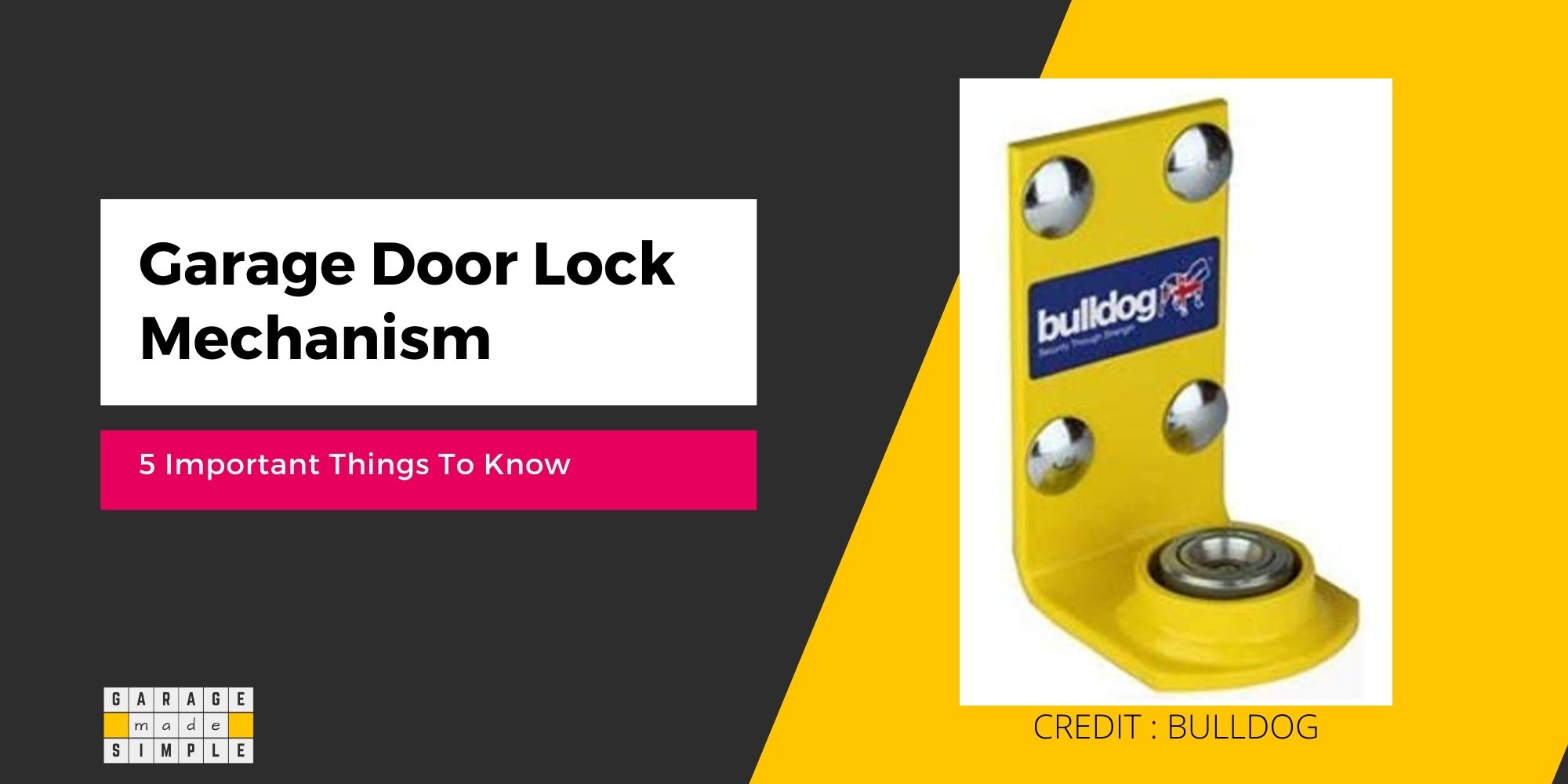Garage Door Safety Sensors: 10 Important Things to Know!
garagemadesimple.com is a participant in the Amazon Services LLC Associates Program, an affiliate advertising program designed to provide a means for sites to earn advertising fees by advertising and linking to Amazon.com . The website is also an affiliate of a few other brands.
At the press of a button on the garage door control or the remote the door starts moving down. But what if your kid or your pet was to walk under the garage door while it is closing? How will an accident be averted? No need to worry! Garage Door Safety Sensors will stop and reverse the door immediately.
1. What is a Garage Door Safety Sensor?
The garage door safety sensors (aka garage door electric eyes) consist of two units installed on the two sides of the garage door. The two units are connected with each other with an infra red (IR) beam that is invisible to the human eye.
The electric circuit of the garage door opener is designed to operate and close the door, as long as the IR beam is intact and the two sensors are connected. The instant this low-voltage, invisible IR bridge is broken the garage door opener motor will stop and reverse.
The garage door will immediately stop closing, and will start opening instead.
The IR beam can be broken by anything solid, such as a child, a pet, a car tire or even a basketball.

Legislation
The US government passed a law in 1993 that all electric garage doors must be equipped with garage door safety sensors to avert the risk of entrapment & accidents, which could even be fatal.
“The legislation requires that automatic residential garage door openers manufactured on or after January 1, 1991 conform to the entrapment protection requirements of the Underwriters Laboratories (UL) Standard for Safety, UL 325.
The legislation also requires that residential garage door openers manufactured on or after January 1, 1993 comply with additional entrapment protection requirements developed by UL.
-External entrapment protection device, such as an “electric eye” which “sees” an object obstructing the door without having actual contact with the object. Another similar device would be a door edge sensor. The door edge sensor acts much like the door edge sensors on elevator doors.”

2. Where are the Sensors located on the Garage Door?
The two units of the garage door sensors must be attached to the sides of the garage door, one to each side. One of the units sends the infra red beam and the other receives it. When the two units are perfectly aligned and there is no blockage, the receiving unit “sees” the sending unit.
This is the reason the garage door safety sensors are also known as garage door electric eyes!
The height of the garage door sensors above the garage floor is very important. Generally the sensors are fixed 6 inches above the floor.
If fixed higher, a small pet or car part may lie undetected under the garage door. If fixed at a lower height an adult could be straddling the IR beam without breaking it.
3. Why do Garage Door Sensors go bad?
Garage door sensors may malfunction at times. When they malfunction, you will know, because you will not be able to close the garage door. The garage door opener circuit includes the invisible infrared (IR) beam between the two sensor units.
A sensor malfunction essentially means that the IR beam is either not there or is not reaching the receiving sensor.
The reasons the IR beam is not there will be usually
No Power Supply
Of course the sensor will not work if there is no power supply to the sensor. If you see that one or both LEDs on the sensor are not lit, then the sensors do not have power supply.
Check the electrical wires leading to the sensor. They may be damaged or disconnected.
Faulty Sensor Parts
Your garage door safety sensor is basically a photoelectric sensor. It consists of a light source (LED) in one unit, a receiver (phototransistor) in the other unit, a signal converter, and an amplifier. The phototransistor analyzes the incoming light, verifies that it is from the LED, and appropriately triggers an output.
Any of these parts may have blown. This is all electronics and we know that this happens. It could be age, it could be vibration. Whatever the reason, you need to replace your sensors.
However, if the sensors have power and the garage door is still not closing then the IR beam is not reaching the receiving sensor. In this case the LED will be blinking. This could happen due to
Misalignment
Since the garage door safety sensors are placed pretty low, there is a high chance that they may get hit by foot, furniture or equipment. A hit may be enough to change the direction of the IR beam so that it no longer points to the lens on the receiving sensor.
This can be fixed using a string and a level. For detailed instructions check out “How to Align Garage Door Sensors” on wikiHow.
Obstruction
Sometimes the problem may be as simple as some object such as a box or a garden equipment blocking the IR beam path. Just check for it visually and remove it from the path.
It is also possible that the sensor lenses are really dirty. Simply cleaning them may get your garage door working again!
4. Why Do Garage Door Safety Sensors Need to Be Reset?
Garage door safety sensors need to be reset when they malfunction or become misaligned. Misaligned sensors can cause the garage door to stop functioning properly, and in some cases, the door may not close at all.
To reset the sensors, you need to check if they are aligned correctly. If they are not, you can adjust them by removing the receiving sensor from the bracket and pointing it away from the sending sensor so that the light is completely off.
Once the light is off, wait for 10 seconds, slowly rotate the sensor back, aligning it with the sending sensor until it lights up to green again. When you have a strong green light, put it back into the bracket and put the wing nut back on.
Disabling garage door safety sensors permits the door to close even when there is something or someone under it. This is dangerous as it can cause damage, injury, and even death.
5. Can Sunlight affect Garage Door Sensors?
Yes the sunlight can affect the garage door sensor.
The garage door sensor units use infrared (IR) waves. Sunlight has infrared rays. In fact they are much stronger than the infrared rays emitted by the sending unit of the garage door sensors.
If the sunlight falls directly on the receiving sensor, then this may confuse the sensor and it will not function. The garage door can be opened but can not be closed in such a situation.
There are three possible solutions to this problem.
Shielding
Shielding the lens of the receiving sensor from the sunlight by using an opaque cardboard or PVC tube may help. Just ensure the sunlight is blocked but the IR beam from the transmitting unit is not blocked.
This is a simple solution, but it does look a bit crude. If you want some class, why not get Garage Door Eye Sensor Shield Cover Protector Kit from Amazon.
Moving Back
If the sunlight does not penetrate deep inside the garage then you could move the garage door safety sensors back, that is more inside the garage. Hopefully the sunlight will then not interfere with the receiving sensor.
Switching
Another option available to you may be to switch the positions of the two sensor units. For example, if the receiving sensor currently faces south, then it would be receiving a lot of sunlight around mid-day.
Now if you switch the sensor position, the receiving sensor will face north. The sunlight is less likely to interfere with its functioning.
6. Can Garage Door Sensors get Wet?
Garage Door Sensors can get wet for a variety of reasons. Of course the most obvious & frequent reason would be rain & maybe even flooding of the garage and the neighborhood.
The garage door may have been open when it started raining. If the rain is accompanied by strong winds then the sensor may get wet. The sensor may also get wet when you drive past and there is water pooling near the garage door.
You can avoid this situation. Read my earlier blog post How To Make Sure Its Dry? Garage Floor Water Diverter Is Helpful!
The sensor circuit can get wet due to condensation even without any rainfall. Condensation happens when warm humid air comes in contact with a cold surface of the sensor and cools down to below the dew point.
To find out the steps that you can take to prevent condensation read my blog post How To Make Sure Of No More Damp Garage Floors
Moisture is never good for electronic or electrical gadgets as it can lead to short circuits. The other problem, especially with condensation, is fogging of the sensor lens. This can also cause the sensor to malfunction.
7. Can you Clean Garage Door Sensors?
Garage door sensors are usually totally ignored, till they give a problem. As they are low down, near the floor they can collect dust and even cobwebs.
Make it a point to clean them at least once a month. However, do the cleaning as gently as possible. You do not want to disturb the alignment.
Clean the sensor lens using a soft microfiber cloth, the type you use to clean eyeglasses or TV screens. If the lens is still dirty, you can wet the cloth with some water or use a mild glass cleaning liquid. Do not use any strong cleaning solutions.
8. How to Check Garage Door Safety Sensors?
It is also a good idea to check garage door safety sensors at least once a month. It is actually quite a simple procedure.
Open your garage door first and then press the button to close it. As the garage door is closing, push an empty cardboard box in the line of the sensors.
The garage door should immediately stop and reverse, if the garage door sensors are aligned and functioning properly.
Of course if the LED indicator lights on the sending and receiving sensors are flashing then the safety beams are misaligned.
9. Will Garage Doors Work without Sensors?
Garage door safety sensors are a mandatory feature of the garage door operator (GDO) as per Federal Law and UL 325. The garage door will open without sensors but will not close without fully functioning sensors.
But what do you do if your garage door gets stuck in an open position, either due to a malfunctioning garage door sensor or any other reason. Your immediate concern would be to get the door down and secure the garage.
The way to do this is by disengaging the garage door opener by using the emergency release cord.
This has to be done very carefully to ensure that the door does not come crashing down!
You need to measure the exact gap between the garage floor and the lower edge of the door. Then saw off two pieces of 2X4 and jam it under the garage door. This will support the garage door once you pull the emergency release.
The garage door can be lowered to the floor after disengaging the GDO with the help of a couple of strong bodied friends.
10. How much does it Cost to Replace Garage Door Sensors?
A set of Garage Door Sensors will cost you a little over $30 at Amazon.
Thank you very much for reading the post. I do hope you found it informative and useful.







